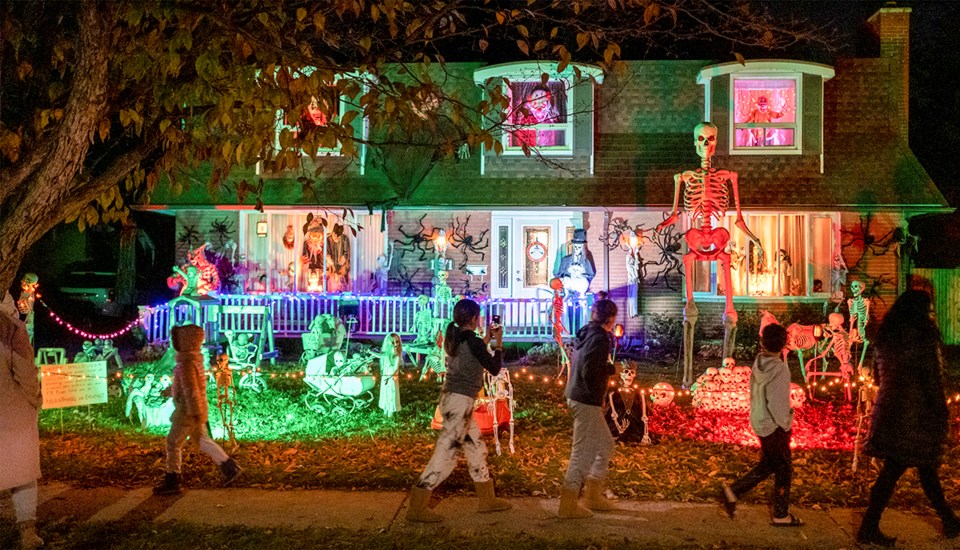As Halloween approaches, some families have been eagerly decorating their homes to celebrate the spooky season. However, an unsettling trend has emerged in recent years: the proliferation of gruesome lawn decorations that can be deeply traumatizing, especially for young children. Unlike the warm and festive spirit of Christmas decorations—often filled with joy, light, and community—these Halloween displays often evoke fear, anxiety, and confusion.
For children, distinguishing between reality and fantasy can be a challenging task. According to Rudolph Steiner, expert in child development and founder of Waldorf education principles, children learn best through imaginative play and storytelling, which help them develop a sense of security in their understanding of the world. Yet, when confronted with vivid depictions of violence, death, and horror—such as bloody figures or dismembered limbs—children's natural instincts to feel safe and secure are severely compromised. Research shows that exposure to frightening stimuli can lead to an increase in anxiety disorders, PTSD, and other emotional disturbances in children. A study published in the journal Child Development found that children exposed to traumatic events are more likely to experience long-term psychological issues, affecting their ability to form secure attachments and regulate their emotions.
Moreover, we must consider the broader implications of such decorations on our communities. For those who have fled war-torn countries, Halloween displays can evoke memories of trauma, violence, and loss. What may seem like harmless fun to some can serve as a harsh reminder of their past experiences for others, reinforcing feelings of fear and instability.
In fact, there are children in our community who have become too afraid to go out trick-or-treating, forcing them and their families to avoid whole streets. As a parent, I find this season extremely disheartening and hard to navigate. I have had the privilege of speaking with many other families in our community about this topic, who have shared with me that their children too - are terrified, and unable to go out this Halloween. It’s disheartening to think that a simple walk or drive to school or a visit to their favourite park can be overshadowed by immense fear. While adults can choose to indulge in macrame and horror, children are subjected to these frightening displays without choice, and it simply isn’t okay or fair.
Studies indicate that prolonged exposure to fear-inducing environments can have lasting effects on children’s cognitive development. According to research by the American Psychological Association, chronic stress caused by fear can impair a child's ability to learn, concentrate, and process information, potentially affecting their academic performance and social skills as they grow. While this may sound over the top to some, I can assure you that I have witnessed extreme fear firsthand from my own child having to exist in our community filled with gruesome displays, as well as other children expressing trauma-like symptoms due to Halloween.
As a society, we should aim to create spaces that foster inclusivity, understanding, and compassion, rather than fear and distress. It is essential to recognize that having our children live in fear— from monstrous lawn figures —should never be the goal of our celebrations. Halloween can be an opportunity to engage children’s imaginations and creativity without resorting to horror and shock. We can encourage traditions that celebrate the beauty of autumn, the fun of costumes, and the joy of community gatherings while being mindful of the emotional impact of our adult choices. In speaking with a teacher in our community about Halloween, their words have haunted me. "We live in a society that does not value children and childhood."
I implore you, if you are the owner of one of these lawns, to reconsider your choices. We share our community, and it is vital that we create an environment where all children feel safe and welcome. By choosing to decorate with care—focusing on friendly ghosts, whimsical pumpkins, and playful witches—we can create a Halloween that invites joy rather than fear.
While we all want to enjoy the spirit of Halloween, let us remember the profound effects that gruesome decorations can have on children and vulnerable community members. By fostering an atmosphere of compassion and creativity, we can celebrate Halloween in a way that nurtures, rather than traumatizes, the hearts and minds of our children.
Cassandra Nordell-MacLean is a local business owner and home-educating parent, born and raised in Sarnia ON.
